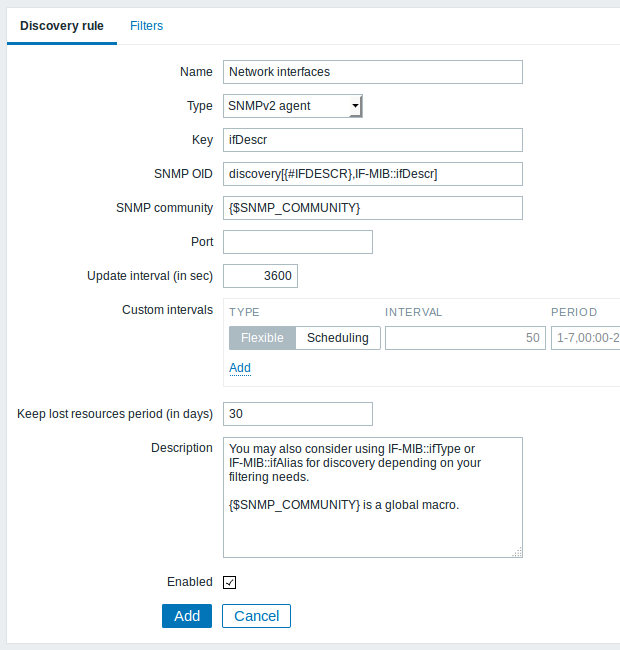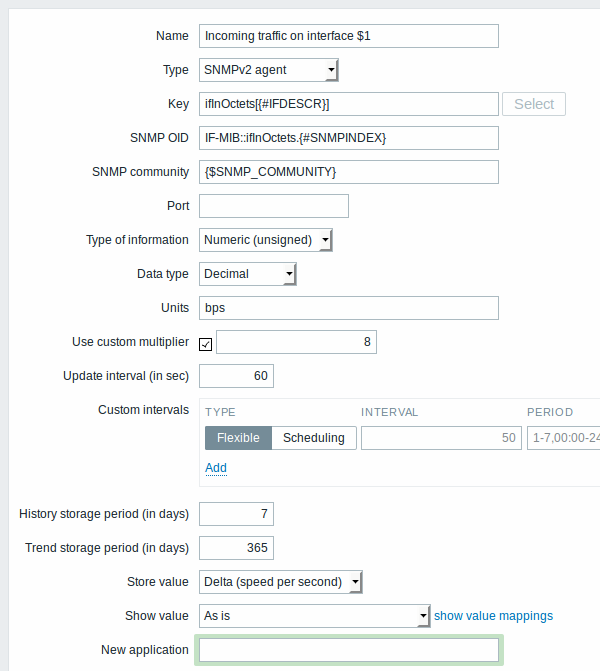Unlike file system and network interface discovery, the item does not necessarily have to have “snmp.discovery” key - item type of SNMP agent is sufficient.
The OIDs to discover are defined in SNMP OID field in the following format: discovery[{#MACRO1}, oid1, {#MACRO2}, oid2, …,]
where {#MACRO1}, {#MACRO2} … are valid lld macro names and oid1, oid2… are OIDs capable of generating meaningful values for these macros. A built-in macro {#SNMPINDEX} containing index of the discovered OID is applied to discovered entities. The discovered entities are grouped by {#SNMPINDEX} macro value.
To understand what we mean, let us perform few snmpwalks on our switch:
$ snmpwalk -v 2c -c public 192.168.1.1 IF-MIB::ifDescr IF-MIB::ifDescr.1 = STRING: WAN IF-MIB::ifDescr.2 = STRING: LAN1 IF-MIB::ifDescr.3 = STRING: LAN2 $ snmpwalk -v 2c -c public 192.168.1.1 IF-MIB::ifPhysAddress IF-MIB::ifPhysAddress.1 = STRING: 8:0:27:90:7a:75 IF-MIB::ifPhysAddress.2 = STRING: 8:0:27:90:7a:76 IF-MIB::ifPhysAddress.3 = STRING: 8:0:27:2b:af:9e
And set SNMP OID to: discovery[{#IFDESCR}, ifDescr, {#IFPHYSADDRESS}, ifPhysAddress]
Now this rule will discover entities with {#IFDESCR} macros set to WAN, LAN1 and LAN2, {#IFPHYSADDRESS} macros set to 8:0:27:90:7a:75, 8:0:27:90:7a:76, and 8:0:27:2b:af:9e, {#SNMPINDEX} macros set to the discovered OIDs indexes 1, 2 and 3:
{ "data": [ { "{#SNMPINDEX}": "1", "{#IFDESCR}": "WAN", "{#IFPHYSADDRESS}": "8:0:27:90:7a:75" }, { "{#SNMPINDEX}": "2", "{#IFDESCR}": "LAN1", "{#IFPHYSADDRESS}": "8:0:27:90:7a:76" }, { "{#SNMPINDEX}": "3", "{#IFDESCR}": "LAN2", "{#IFPHYSADDRESS}": "8:0:27:2b:af:9e" } ] }
If an entity does not have the specified OID, then the corresponding macro will be omitted for this entity. For example if we have the following data:
ifDescr.1 "Interface #1" ifDescr.2 "Interface #2" ifDescr.4 "Interface #4" ifAlias.1 "eth0" ifAlias.2 "eth1" ifAlias.3 "eth2" ifAlias.5 "eth4"
Then in this case SNMP discovery discovery[{#IFDESCR}, ifDescr, {#IFALIAS}, ifAlias] will return the following structure:
{ "data": [ { "{#SNMPINDEX}": 1, "{#IFDESCR}": "Interface #1", "{#IFALIAS}": "eth0" }, { "{#SNMPINDEX}": 2, "{#IFDESCR}": "Interface #2", "{#IFALIAS}": "eth1" }, { "{#SNMPINDEX}": 3, "{#IFALIAS}": "eth2" }, { "{#SNMPINDEX}": 4, "{#IFDESCR}": "Interface #4" }, { "{#SNMPINDEX}": 5, "{#IFALIAS}": "eth4" } ] }
建立snmp discovery 规则,SNMP OID:discovery[{#IFDESCR},IF-MIB::ifDescr],
意思就是 snmpget 所有 IF-MIB::ifDescr 的值存放在 #IFDESCR 这个Marco(宏)里面,按照 #SNMPINDEX=1,2,3 排列存储。

The following screenshot illustrates how we can use these macros in item prototypes:
创建 Item Prototypes规则,name里面的 $1 参数就是 key 里面传回的第一个参数,也就是 Discovery rule里面获得的 #IFDESCR 【对应#SNMPINDEX】的值。
返回的真实值就是:snmpget 的 SNMP OID 里面的IF-MIB::ifInOctets.{#SNMPINDEX}的值,SNMP community 对应的是添加主机时候设置的团体名。

当然也可以自己用snmpwalk命令一一指定要监控的某个具体的端口。